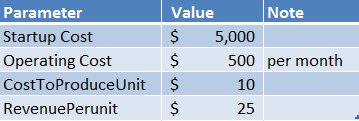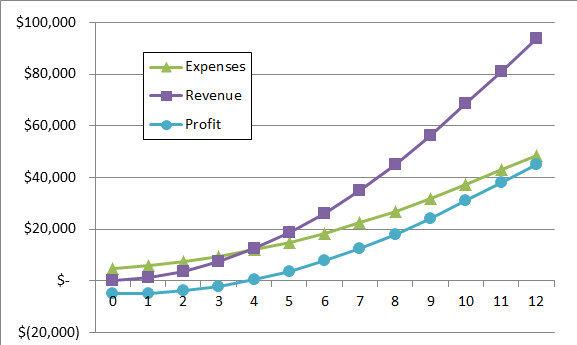How to Estimate Your Startup’s Finances
 You have a great start-up idea. The market is interested. The technical barriers have been passed. You are serious about making it a business. Before you pull the trigger, the questions is “will it fly?”
You have a great start-up idea. The market is interested. The technical barriers have been passed. You are serious about making it a business. Before you pull the trigger, the questions is “will it fly?”
If you haven’t done it already, now is the time to check the feasibility of the financials. I’m not talking about 5-year monthly projections. I’m not talking about hiring an accountant. I’m talking about an estimation exercise – a basic back-of-the-envelope calculation to answer questions such as
- Will this business be profitable long term?
- How many widgets do I have to sell to hit my financial goals for the business?
- Am I charging enough for my services to cover my costs and make a profit?
- Does the model I’m considering make sense for a business, rather than a hobby?
 Fundamentally, to answer these questions you need two types of information:
Fundamentally, to answer these questions you need two types of information:
- What are my costs/expenses?
- What are my sources of income/revenue?
The answers to these questions depend completely on the specifics of your business, so rather than try to tell you an answer I’m going to share a method of finding the answers.
Part I – Expenses
 Start with a blank piece of paper or empty document. First, I want you to brainstorm all the different types of things you will need to spend money on. Some will be obvious so add those right away to your paper.
Start with a blank piece of paper or empty document. First, I want you to brainstorm all the different types of things you will need to spend money on. Some will be obvious so add those right away to your paper.
To make sure you haven’t missed something, do a few thought exercises:
Mentally walk through your client or customer’s experience to determine your costs associated with each step —
- How do they find out about you (marketing, advertising, sales, Internet presence)?
- How do they start to make a purchase (walk into store, call on phone, see product at dealer, meet company at conference)?
- How does the purchase happen (Online sale, physical sale, create contract)?
- How is the product delivered (electronically, physically, order fulfillment, shipping, professional services, travel)?
- What happens after the sale (follow-up, returns, customer support, collections)?
Mentally walk through the mechanics of running your organization–
- Physical location and facilities (store, office, warehouse, manufacturing, computers and equipment).
- Human Resources (how many people and what roles to fulfill all the above functions).
- Overhead (taxes, accounting, human resources/hiring, legal)
Some of these items will float to the top as key expenses while others are small in comparison. Spend more time and more granularity estimating the larger expenses and use broad assumptions for the smaller ones or simply neglect them for this calculation.
For each expense, note if that expense is one-time or ongoing. Also note if that expense is mostly fixed or scales as your sales grow. Later, this will help you determine how high sales need to be to reach break-even or profitability levels desired.
Part II – Revenue
 This is typically the easier part to do, since, as an entrepreneur, you have probably spent countless hours already imagining selling your product or service and reaping the rewards.
This is typically the easier part to do, since, as an entrepreneur, you have probably spent countless hours already imagining selling your product or service and reaping the rewards.
There are still aspects of your sales that you may not have considered. Are you primarily relying on a single homogeneous revenue stream or are there multiple distinct revenue streams in your business? You may need to consider each stream independently as you evaluate how you focus your energy. Which is your primary profit center?
First, determine the metric that defines your revenue stream (units sold, hours worked, contracts signed, clients acquired, etc). This is a Unit. Make all estimates on the sales and expense side relative to this unit. Your unit may be a single transactional sale or recurring relationship (billed per period). For the later see the notes below in parenthesis.
You then need to determine
- Revenue per unit (or per unit per period).
- Number of units sold over time (or total active units over time).
Let’s tackle these one at a time.
Revenue per Unit
Is there a price point or range for your product or service already established in the market? If so, how to you want to set your price relative to this price point?
If the market has not yet dictated a price, how do you want to position yourself? What are the alternatives that your clients would be spending money on and how do you compare in value?
Number of Units
What are reasonable expected unit sales in your market based on what others are doing, the size of the market, the capability of your sales engine, and the capacity of your delivery systems?
Part III – The Calculation
0th Order Estimate
Start with an order-of-magnitude, down-and-dirty, rough approximation.
Write your expenses as
Write your revenue as
If your (CostPerUnit) is larger than your (RevenuePerUnit), stop and rethink your business model. Otherwise, your initial break-even point, in Units, is
How long do you think it will take you to sell and deliver that many Units? Is that a reasonable business or do you need to rethink your model?
Based on your initial break-even duration, you should adjust your FixedOperatingCost to account for keeping your doors open that long and run the formula again to improve the estimate.
1st Order Estimate
To take this a level deeper, bring in time as a variable, because you have fixed expenses each month whether or not you sell or deliver any units. Using Period to represent the unit of time used (typically a month) we get
Expenses are your fixed Startup Costs, plus the sum over each period of the Operating Cost for that period and the cost of good sold in that period. You will need to estimate have many Units you expect to sell each period, keeping your 0th order estimate in mind.
Your revenue is then
Revenue is simply the sales price times the number of units sold each period.
You can then graph total revenue and expenses over time by estimating the number of units you expect to sell per period.
Example
Our example is XYZ Widget company. It will cost $5000 to make the widget tooling in order to produce our soon to be famous widgets. Widgets cost $10 to build and we will sell them for $25, making a nice profit margin. Our overhead cost to keep our doors open, website, and advertising is $500/month.
This is our expected production. We of course expect sales to grow steadily as word gets out about how great our widgets are. The Units Sold are the new sales that month. We will grow over time and then stabilize at 500 Units per month. The expenses, revenue, and profit below are cumulative through the life of the business. We have passed break-even and are profitable in month 4!
Here is the pretty graph we show our potential investors:
Have fun and good luck with your business. Save the envelope you take your notes on. One day it may be a collector’s item!



3 comments for “Your Business – Will it fly?”